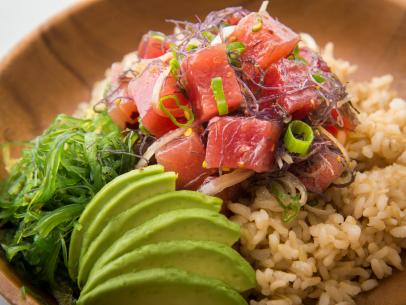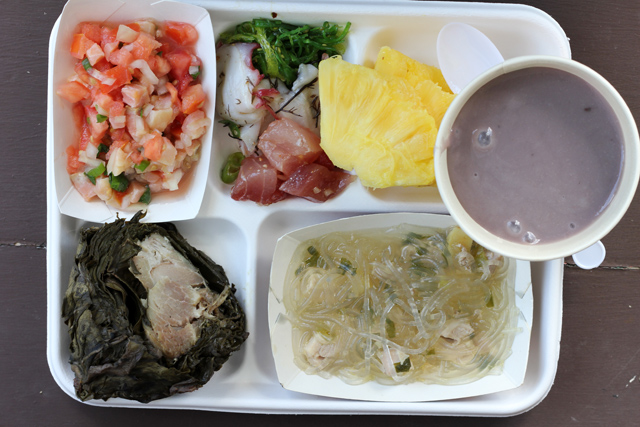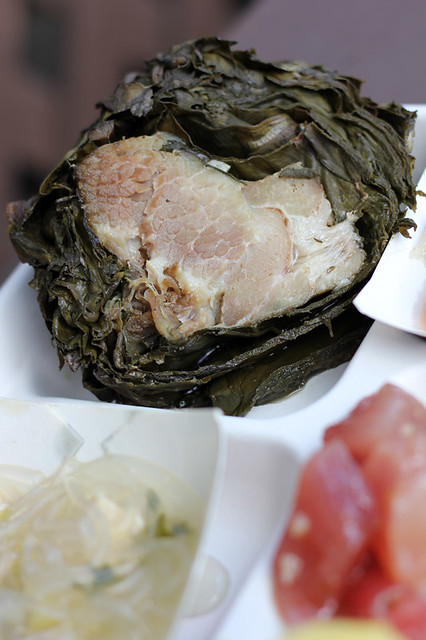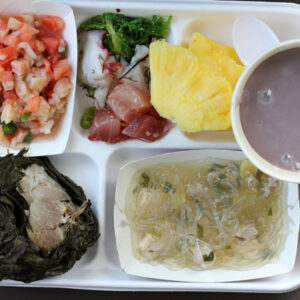Have you ever wondered about the delectable delights found in the Hawaiian Islands? Hawaii is not only known for its stunning beaches and breathtaking landscapes but also its unique and vibrant food culture. From succulent seafood to luscious tropical fruits, the local cuisine in Hawaii is a blend of flavors influenced by various cultures, including Polynesian, Asian, and American. So, prepare your taste buds for an unforgettable culinary adventure as we explore the mouthwatering delicacies that make Hawaii a true food lover’s paradise.

Japanese Influence on Hawaiian Cuisine
Hawaii’s culinary scene is a delightful blend of diverse culinary traditions from around the world, and one of the most significant influences on Hawaiian cuisine is from Japan. The fusion of Japanese flavors and techniques with local Hawaiian ingredients has given birth to a unique and mouth-watering culinary experience. From sushi to mochi, let’s explore the delicious Japanese-inspired dishes that have become staples in Hawaiian cuisine.
Sushi
Sushi, a Japanese delicacy that originated in the 8th century, has found a second home in Hawaii. The abundance of fresh seafood in the Hawaiian waters makes it the perfect place to enjoy sushi. Whether you prefer traditional nigiri sushi or creative maki rolls, Hawaiian sushi restaurants offer an array of options to satisfy every taste bud. From classic combinations like tuna and salmon rolls to innovative fusion creations featuring tropical fruits and local ingredients, there’s something for everyone to enjoy.
Poke
Poke, a traditional Hawaiian appetizer made of diced raw fish, has been heavily influenced by Japanese cuisine. The Japanese introduced soy sauce and sesame oil into this Hawaiian staple, creating a delicious fusion of flavors. Today, poke bowls are a popular and ubiquitous dish found in many Hawaiian restaurants. Customizable and bursting with fresh ingredients like marinated tuna, octopus, and salmon, poke bowls offer a refreshing and healthy option that is greatly enjoyed by locals and visitors alike.
Musubi
Musubi, a popular Japanese snack, has become a beloved part of Hawaiian cuisine. This simple yet satisfying dish consists of a block of rice topped with a slice of grilled Spam and wrapped in a strip of dried seaweed. Musubi can be found everywhere in Hawaii, from convenience stores to local food trucks. The combination of the Japanese influence and the availability of Spam during World War II has made musubi a staple in Hawaiian culture, and it continues to be a delicious grab-and-go snack enjoyed by locals and tourists.
Tempura
Tempura, a Japanese cooking technique of deep-frying ingredients in a light and crispy batter, has seamlessly made its way into Hawaiian cuisine. From shrimp and vegetables to fish and even ice cream, tempura is a delightful way to enjoy the flavors and textures of Hawaii’s fresh produce and seafood. Whether as a standalone dish or incorporated into other Hawaiian favorites, tempura adds an extra layer of texture and flavor that satisfies the cravings of both locals and visitors.
Mochi
A popular Japanese sweet treat, mochi, has made its way into the hearts and mouths of Hawaiians. Mochi is a soft and chewy rice cake made from pounded glutinous rice. Often filled with flavors like red bean paste, tropical fruits, or even ice cream, this delightful confectionery is a favorite dessert among locals. Mochi ice cream, a fusion of Japanese and Western flavors, has also gained immense popularity in Hawaii, offering a refreshing and unique frozen treat.
Traditional Hawaiian Dishes
While the Japanese influence has played a significant role in shaping Hawaiian cuisine, it is essential to explore the traditional dishes that have been enjoyed by the native Hawaiians for centuries. Rich in history and culture, these dishes offer a glimpse into the culinary traditions that have withstood the test of time.
Laulau
Laulau is a traditional Hawaiian dish made by wrapping pieces of pork, chicken, or fish in taro leaves and then steaming them to perfection. The result is a tender and flavorful bundle of meat and vegetables. The slow cooking process allows the flavors to meld together, creating a dish that is truly unique to the islands. The taro leaves infuse the protein with a distinct earthy taste, making laulau a must-try dish for those seeking an authentic Hawaiian culinary experience.
Poi
Poi is a staple food in Hawaiian cuisine that has been a part of the island’s history for centuries. Made from the root of the taro plant, poi is a starchy and creamy paste that is a significant source of nutrition for the Hawaiian people. Traditionally, the taro root is steamed, pounded, and mixed with water to achieve the desired consistency. Poi has a slightly sour taste and is often described as an acquired taste. It is commonly eaten as a side dish or used as a condiment to complement other Hawaiian dishes.
Kalua Pig
Kalua pig is a quintessential Hawaiian dish that embodies the flavors and traditions of the islands. Traditionally cooked in an imu, an underground oven, kalua pig is prepared by wrapping a whole pig in banana leaves, seasoning it with sea salt, and slow-roasting it for hours. The result is tender, juicy, and flavorful meat with a smoky aroma. The kalua pig is often served at luaus, Hawaiian feasts, and is accompanied by other traditional dishes, creating a feast that celebrates the spirit of Aloha.
Lomi Lomi Salmon
Lomi lomi salmon is a refreshing and vibrant dish that showcases the influence of Pacific Island cuisine on Hawaiian cooking. The dish consists of diced salmon, tomatoes, onions, and crushed ice, all mixed together with a touch of salt. The name “lomi lomi” refers to the traditional Hawaiian massage technique where the ingredients are massaged together, creating a delightful, harmonious blend of flavors. The refreshing combination of the cool salmon and the tangy tomatoes makes lomi lomi salmon a popular appetizer or side dish, perfect for hot Hawaiian days.
Haupia
Haupia is a sweet coconut pudding that has become an iconic dessert in Hawaiian cuisine. Made from coconut milk, sugar, and cornstarch, haupia has a smooth and creamy texture that melts in your mouth. Often served in squares or as a filling in pastries, haupia can be enjoyed on its own or alongside other Hawaiian desserts. Its rich coconut flavor transports you to the tropical beauty of the islands, making it a perfect ending to any Hawaiian meal.
Explore Uncharted Hawaiian Destinations
Asian Fusion Cuisine
As Hawaii is a melting pot of different cultures, the influence of Asian cuisines doesn’t stop at Japanese dishes. Asian fusion cuisine has become a prominent part of the Hawaiian culinary landscape, combining flavors and techniques from various Asian countries with local Hawaiian ingredients. Here are some beloved Asian fusion dishes that have become staples in Hawaiian cuisine.
Plate Lunch
The plate lunch, also known as a mixed plate, is a popular and satisfying Hawaiian meal that often reflects the diversity of Asian flavors. This hearty dish typically consists of a generous portion of rice, macaroni salad, and a choice of protein, such as teriyaki chicken, Korean barbecue, or beef curry. The plate lunch concept originated in the early 20th century when immigrant plantation workers from various Asian countries wanted a filling and affordable meal during their breaks. Today, plate lunches can be found throughout the Hawaiian islands, serving as a delicious testament to the fusion of Asian and Hawaiian culinary traditions.
Loco Moco
Loco moco is a comfort food dish that originated in Hawaii and blends American, Japanese, and Polynesian influences. This hearty dish features a mound of white rice topped with a hamburger patty, a fried egg, and smothered in rich brown gravy. Loco moco is the ultimate indulgence and a popular choice for breakfast, lunch, or even dinner. The combination of flavors and textures creates a satisfying meal that is beloved by locals and visitors alike.
Garlic Shrimp
Garlic shrimp is a mouth-watering dish that showcases the influence of Asian cuisine, particularly from China, on Hawaiian cooking. Large shrimp are marinated and sautéed in a garlic-infused butter sauce until they become juicy and succulent. The dish is typically served with a side of rice and a squeeze of fresh lemon. Garlic shrimp trucks are a common sight along the North Shore of Oahu, offering locals and tourists a finger-licking experience that highlights the delicious marriage of flavors between Asian and Hawaiian culinary traditions.
Shoyu Chicken
Shoyu chicken is a flavorful and tender dish that draws its roots from Japanese teriyaki chicken. The chicken is marinated in a soy sauce-based mixture, featuring a combination of soy sauce, ginger, garlic, and other aromatic ingredients, before being grilled or pan-cooked to perfection. The result is a delightful blend of sweet and savory flavors that perfectly complement the succulent chicken. Shoyu chicken is a popular choice for Hawaiian barbecues or as a filling for sandwiches or tacos, offering a taste of Asian fusion cuisine that satisfies every palate.
Seafood Delicacies
With its surrounding abundant ocean, it’s no surprise that seafood plays a significant role in Hawaiian cuisine. From fresh fish caught off the shores to delectable poke bowls, there is an array of seafood delicacies to enjoy in Hawaii. Let’s explore some of the mouth-watering seafood options that have become synonymous with the islands.
Fresh Fish
When it comes to fresh fish, Hawaii is a seafood lover’s paradise. The islands are surrounded by some of the richest fishing grounds in the world, offering an unparalleled selection of fresh and flavorful fish. From the prized yellowfin tuna, known as ahi, to the delicate and buttery ono, there is a wide variety of fish to choose from. Whether enjoyed as sashimi, grilled, or incorporated into various dishes, the freshness and quality of Hawaiian fish elevate any seafood dining experience.
Ahi Poke
Poke bowls have become a culinary sensation in recent years, and ahi poke takes the spotlight as one of the most popular varieties. Ahi poke features fresh, raw ahi tuna, marinated with a combination of soy sauce, sesame oil, green onions, and other seasonings. The result is a dish bursting with umami flavors and a tantalizing texture. Enjoyed on its own or served over a bed of rice or salad greens, ahi poke showcases the best of Hawaiian seafood and has become a must-try dish for seafood enthusiasts.
Mahi Mahi
Mahi Mahi, also known as dolphin fish, is a prized catch in Hawaiian waters. With its firm texture and mild, slightly sweet flavor, mahi mahi is a versatile and delicious fish to cook with. Whether grilled, fried, or blackened, mahi mahi holds its shape and can be paired with various sauces and seasonings to create a wide range of flavorful dishes. Its delicate taste and flaky flesh make it a favorite choice for seafood lovers and a staple on menus across Hawaii.
Opah
Opah, also known as moonfish or sunfish, is a distinctive and vibrant fish found in Hawaiian waters. With its striking colors and unique anatomy, opah has gained popularity among local chefs and seafood enthusiasts. Opah’s flesh is moist, rich, and tender, making it a delight to eat. Whether seared, grilled, or served raw, opah offers a flavor profile that is incomparable and a texture that is simply delightful. If you have the opportunity to try opah during your time in Hawaii, don’t miss out on this exquisite seafood delicacy.

Plan Your Dream Hawaiian Getaway
Luau Food
A luau is a traditional Hawaiian feast that celebrates special occasions, such as weddings, birthdays, or graduations. These festive gatherings are filled with cultural performances, music, and, of course, an abundance of delicious food. While a luau typically features a wide variety of dishes, a few staples have become synonymous with this vibrant celebration.
Kalua Pig
Kalua pig is the centerpiece of a traditional Hawaiian luau. As mentioned earlier, this dish is prepared by slow-cooking a whole pig in an underground oven called an imu. The result is succulent, tender meat that falls off the bone, infused with the smoky flavors of the banana leaves and the sea salt used during the preparation. Kalua pig is often served shredded or sliced and exudes the essence of Hawaiian culture and tradition.
Poi
Poi, a traditional Hawaiian staple, is also an essential part of any luau. As discussed earlier, poi is made from the root of the taro plant and has a unique texture and flavor. During a luau, poi is typically served alongside other dishes, serving as a starchy accompaniment. Its slightly sour taste adds a refreshing contrast to the rich and savory flavors present in the rest of the feast.
Haupia
To complete the luau feast, haupia is often served as a delightful dessert. As mentioned earlier, haupia is a coconut pudding that is creamy, smooth, and bursting with coconut flavor. Its sweet and tropical taste perfectly rounds off the flavors of the entire meal, allowing guests to enjoy a satisfying and memorable dining experience.
Plantation-Era Dishes
Hawaii’s culinary landscape has been shaped not only by the cultural influences of various immigrant communities but also by the history and legacy of the island’s sugar and pineapple plantation era. During this period, workers from different backgrounds brought their culinary traditions to the islands, resulting in a unique fusion of flavors. Here are some dishes that have become synonymous with the plantation era in Hawaii.
Pancakes
Fluffy, golden pancakes are a breakfast staple that has found a special place in Hawaiian cuisine. The influence of Portuguese immigrants is evident in these pancakes, which are made with sugar and buttermilk for a slightly tangy flavor. Topped with fresh fruit, macadamia nuts, or a drizzle of coconut syrup, pancakes in Hawaii are a delicious way to start the day and pay homage to the diverse heritage of the islands.
Portuguese Sausage
Another culinary creation from the Portuguese immigrants is the mouth-watering Portuguese sausage, also known as linguica. Made from a mixture of pork butt, fat, and various spices, Portuguese sausage has a distinct flavor that sets it apart from other sausages. It is often enjoyed as a breakfast item alongside eggs, rice, and fresh fruit, offering a hearty and satisfying start to the day.
Malasadas
Malasadas, a popular Portuguese dessert, have become a beloved treat in Hawaii. These deep-fried doughnuts are dusted with sugar and often filled with delightful flavors such as guava, haupia, or lilikoi (passion fruit). The crisp exterior and soft, pillowy interior make malasadas an indulgent dessert or a perfect snack any time of the day. Whether enjoyed plain or filled, these treats are a testament to the enduring legacy of the Portuguese community in Hawaii.

Experience Hawaii’s Unique Attractions
Hawaiian Snacks
While exploring the local cuisine in Hawaii, it’s important not to overlook the delightful snacks that have become a part of the island’s food culture. From savory treats to refreshing desserts, these Hawaiian snacks offer a quick and tasty way to experience the flavors of the islands.
Spam Musubi
Inspired by the Japanese onigiri, spam musubi has become synonymous with Hawaiian snacking. It features a slice of grilled Spam placed on a block of rice and wrapped with a strip of dried seaweed. This delightful fusion of Japanese and Hawaiian flavors and ingredients is portable, easy to eat, and incredibly tasty. Spam musubi can be found in convenience stores, local markets, and food trucks throughout the islands, making it a convenient and delicious snack option for both locals and visitors.
Shave Ice
Shave ice is a beloved Hawaiian treat that offers a refreshing way to beat the tropical heat. The ice is shaved into delicate, fluffy flakes that gently melt in your mouth, creating a soft and cooling sensation. This frozen delight is typically topped with an assortment of flavored syrups, ranging from classic options like strawberry and pineapple to unique tropical flavors like li hing mui (dried plum) or passion fruit. Add-ons, such as sweetened condensed milk or a scoop of ice cream, can elevate the shave ice experience to new heights. Whether enjoyed on a sunny beach day or as a sweet ending to a meal, shave ice is an essential part of the Hawaiian snacking scene.
Manapua
Manapua, a variation of the Chinese cha siu bao, is another popular snack that has become an island favorite. It consists of steamed or baked buns filled with a savory and sweet barbecue pork filling. The mixture of Chinese and Hawaiian influences in manapua creates a unique flavor profile that is irresistibly delicious. These handheld treats can be found in local bakeries and dim sum restaurants, and they make for a satisfying and portable snack.
Influence of Polynesian Cuisine
Hawaii is part of the larger Polynesian region, and the culinary traditions of the Polynesian people have had a significant influence on Hawaiian cuisine. From staple ingredients to traditional cooking techniques, Polynesian cuisine has made its mark on the flavors and dishes of the islands.
Taro
Taro, a root vegetable, holds great cultural and culinary significance in Polynesia and Hawaii alike. It is a versatile ingredient that can be prepared in various ways, such as boiling, baking, or steaming. In Hawaii, taro is often used to make the traditional dish poi, as mentioned earlier. The taro plant is also used to make laulau, where the leaves serve as a wrapper for the meat and create a distinct flavor. Taro’s nutty and slightly sweet taste adds depth and complexity to many Hawaiian dishes, and it remains an important part of both Polynesian and Hawaiian culinary traditions.
Poi
Poi, as mentioned earlier, is an essential part of Hawaiian cuisine and is made from the taro root. However, the preparation and consumption of poi are not unique to Hawaii but are widespread throughout Polynesian cultures. Poi is a versatile staple, served as a side dish, condiment, or even as a main course in traditional feasts and celebrations. The cultural significance of poi and its deep roots in Polynesian history make it an integral part of the culinary tapestry of the islands.
Coconut Milk
Coconut milk, another key ingredient in Polynesian cuisine, is used in various Hawaiian dishes to add richness and flavor. From curries to desserts, coconut milk brings a tropical touch and creamy texture to many Hawaiian recipes. Its versatility and distinct taste make it a beloved ingredient in both savory and sweet dishes, allowing the flavors of the islands to shine through.

Farm-to-Table Movement in Hawaii
Hawaii’s agricultural landscape offers fertile soil and a favorable climate for a wide variety of crops and produce. The farm-to-table movement in Hawaii aims to celebrate and promote the use of locally sourced ingredients, supporting small-scale farmers and establishing a more sustainable food system. From exotic fruits to unique honey and world-renowned coffee, Hawaii’s farm-to-table movement has gained traction and recognition in recent years.
Local Fruits
Hawaii’s tropical climate is a paradise for fruit lovers, offering a wide array of flavorful and exotic fruits. From luscious pineapple and juicy papaya to tangy lilikoi (passion fruit) and sweet mangoes, the variety of fruits grown in Hawaii’s rich soil is astounding. The farm-to-table movement highlights the importance of utilizing these local fruits, promoting their freshness and supporting local farmers. Whether enjoyed on their own, in refreshing smoothies, or incorporated into vibrant salads, locally grown fruits allow locals and visitors to indulge in the flavors of the islands while supporting sustainable agriculture practices.
Honey
Honey produced in Hawaii is a treat for the taste buds, thanks to the diverse range of flowers and plants that bees feast upon. With unique flavors and aromas, Hawaiian honey has gained recognition for its quality and distinctiveness. From the delicate and floral flavors of Lehua honey to the rich and robust taste of Macadamia nut honey, there is a honey to suit every palate. The farm-to-table movement encourages the use of locally produced honey, not only to enhance the flavors of dishes but also to support the vital role that bees play in Hawaii’s ecosystem.
Kona Coffee
Renowned worldwide for its exceptional quality and flavor, Kona coffee is a testament to the success of the farm-to-table movement in Hawaii. Grown in the volcanic slopes of the Kona region on the Big Island, Kona coffee boasts a unique taste profile due to the fertile soil and ideal growing conditions. The careful cultivation and processing methods employed by local farmers ensure that only the finest beans make it to your cup. By enjoying Kona coffee, you are not only savoring a cup of world-class java but also supporting the efforts of local coffee growers and the sustainability of the Hawaii coffee industry.
Celebration Foods
Food has always played a central role in celebrations, and Hawaii’s vibrant culinary scene offers a plethora of delicacies that are perfect for festive occasions. Whether it’s a birthday, anniversary, or a simple get-together, these celebration foods are sure to make any gathering a memorable one.
Lei Cake
Lei cake is a delightful dessert that pays homage to the traditional Hawaiian lei, a symbol of love, respect, and celebration. With its vibrant and colorful layers, lei cake captures the spirit of the islands. The cake is typically made with different flavored layers, such as guava, lilikoi, and Haupia, and is frosted with whipped cream for a light and airy finish. Lei cake is often enjoyed during birthdays and special events, serving as a visual and tasty centerpiece that is sure to impress.
Macadamia Nut Pie
Macadamia nuts are synonymous with Hawaii, and this delicious pie showcases their buttery richness. Macadamia nut pie combines the unique flavor and texture of these nuts with a sweet and creamy filling, often enhanced with coconut or chocolate. The pie is typically served chilled and topped with a dollop of whipped cream for an indulgent treat that highlights the flavors of the islands. Whether enjoyed as a dessert or as a sweet ending to a celebration feast, macadamia nut pie is a delightful way to savor a taste of Hawaii.
Luau Staples
Many of the dishes previously mentioned have long-standing ties to Hawaiian celebrations, particularly luaus. Luaus are joyous gatherings that celebrate the important milestones in a person’s life and Hawaiian culture as a whole. Kalua pig, poi, and haupia, among others, are essential components of a traditional luau, representing the rich heritage and warm hospitality of the Hawaiian people. These dishes are prepared with care and pride, and their presence at a celebration signifies the sharing of love, abundance, and the spirit of Aloha.
In conclusion, Hawaii’s local cuisine is a vibrant and mouth-watering mix of culinary influences from Japan, Polynesia, and beyond. From sushi to laulau, fresh seafood to farm-to-table delights, the flavors and traditions of the islands continue to evolve while staying true to their roots. Whether you’re enjoying traditional Hawaiian dishes, Asian fusion cuisine, or the wide variety of snacks and celebration foods, each bite is a celebration of Hawaii’s rich cultural heritage and the natural bounty of the islands. So, when you find yourself in paradise, embrace the flavors, savor the tastes, and embark on a culinary journey that will surely leave you craving more. Aloha!
